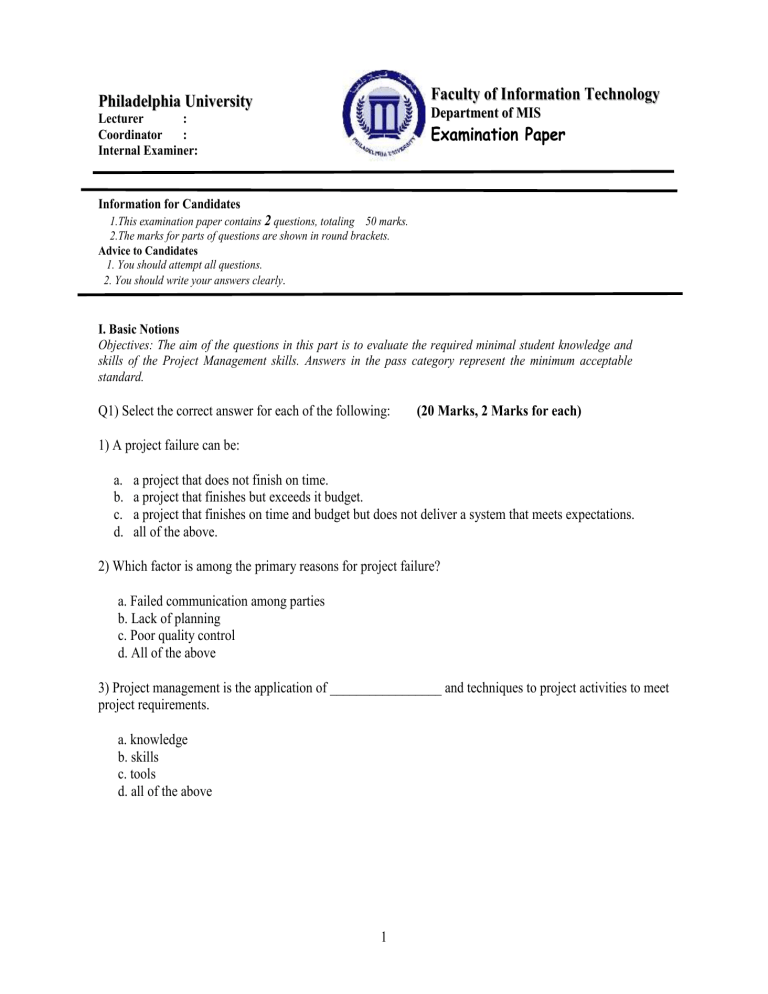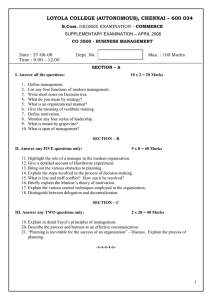P h i

P h i i l l a d e l l p h i i a U n i i v e r s s i i t t y
Lecturer :
Coordinator :
Internal Examiner:
F a c u l l t t y o f f I I n f f o r m a t t i i o n T e c h n o l l o g y
D e p a r t t m e n t t o f f M I I S
Examination Paper
Information for Candidates
1.This examination paper contains 2 questions, totaling 50 marks.
2.The marks for parts of questions are shown in round brackets.
Advice to Candidates
1. You should attempt all questions.
2. You should write your answers clearly .
I. Basic Notions
Objectives: The aim of the questions in this part is to evaluate the required minimal student knowledge and skills of the Project Management skills. Answers in the pass category represent the minimum acceptable standard.
Q1) Select the correct answer for each of the following: (20 Marks, 2 Marks for each)
1) A project failure can be: a.
a project that does not finish on time. b.
a project that finishes but exceeds it budget. c.
a project that finishes on time and budget but does not deliver a system that meets expectations. d.
all of the above.
2) Which factor is among the primary reasons for project failure? a. Failed communication among parties b. Lack of planning c. Poor quality control d. All of the above
3) Project management is the application of _________________ and techniques to project activities to meet project requirements. a. knowledge b. skills c. tools d. all of the above
1
4) A chart showing the start and end dates for the activities of a project is called a: a. Gantt chart. b. Network diagram. c. Work breakdown structure. d. Project activity chart.
5) During the _________________ process, scope, time, cost, and risk planning take place. a. planning b. initiating c. execution d. closeout
6) A planned undertaking of related activities to reach an objective that has a beginning and an end is called: a. an undertaking. b. a project. c. a system. d. a campaign.
7) Project scheduling includes all of the following EXCEPT: a. defining the project’s scope. b.
defining project activities. c.
determining the sequencing of activities. d.
estimating the duration of activities.
8) Why is documentation important for a project? a.
It is valuable for the project team in case they need to trace how a decision was made. b.
It provides a record that can be audited or used as part of a legal defense. c.
It may be used as a source of best practices to improve other projects. d.
All of the above.
9) Perhaps the most important aspect of successful project management is: a. the efficient flow of information. b. participation. c. analysis and action. d. team members’ commitment.
2
10) Which of the following can be considered as a resource that contributes to the accomplishment of project activities a. Personnel and Equipment b.
Contractors c.
Space and Materials d.
All the above
II. Familiar Problems Solving
Objectives : The aim of the questions in this part is to evaluate that the student has some basic knowledge of the key aspects of the lecture material and can attempt to solve familiar problems of the software Project Management topics.
Q2) Answer any three of the following : (Total 30 Marks, 10 Marks each)
A) The Project triangle is an important concept in managing project. Draw that triangle and discuss its component in some details.
B) Software projects Differ in their characteristics from other projects. Discuss that in some details.
C) As a project manager, which generic software process model you prefer to use in a bank system development?
D) Select a project of your own and draw its Bar Chart.
3





